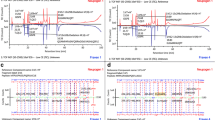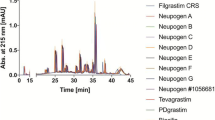Abstract
Purpose
Filgrastim is the generic name for recombinant methionyl human granulocyte colony-stimulating factor (r-metHuG-CSF). It is marketed under the brand name Neupogen® by Amgen. Since this product has lost patent protection, many biosimilar versions have been approved or are in the process of filing for market authorization throughout the world. Here we show that NMR spectroscopy can be used to assess the three-dimensional structure of the active ingredient in the formulated approved product Neupogen®.
Methods
Recombinant metHuG-CSF was prepared in E. coli and isotopically enriched with 13C and 15 N isotopes. NMR spectroscopy was used to study the effects of excipients on the conformation.
Results
The effects of pH variation on the amide chemical shifts suggest the presence of cation-pi interactions between His-79 and Trp-118, and His-156-Trp-58-His-52 that stabilizes the conformation at low pH. This may be associated with a small local conformational change. The NMR data showed that polysorbate does not interact significantly with filgrastim thus allowing the collection of spectra in the presence of 20 times the formulation concentration in the sample. However, at higher detergent concentrations a reduction of signal intensity is observed. Conclusions
The NMR fingerprint assay applied to filgrastim (Neupogen® and a CRS from the European Pharmacopeia (EP)) provided residue specific information of the structure of the drug substance. In addition to current methods, the ability to assess the conformation with a high degree of resolution can greatly facilitate comparability exercises.





Similar content being viewed by others
Abbreviations
- ANC:
-
Absolute neutrophil count
- CMC:
-
Critical micelle concentration
- CRS:
-
Chemical Reference Standard
- EP:
-
European Pharmacopeia
- HSQC:
-
Heteronuclear single quantum coherence
- IMAC:
-
Immobilized metal affinity chromatography
- Met-G-CSF:
-
Recombinant methionyl granulocyte-colony stimulating factor
- PS-80:
-
Polysorbate-80
- SEB:
-
Subsequent entry biologics
References
Parham P. The Immune System 2nd Ed. New York: Garland Science; 2005. p. 227–76.
Zink T, Ross A, Lüers K, Cieslar C, Rudolph R, Holak TA. Structure and dynamics of the human granulocyte colony-stimulating factor determined by NMR spectroscopy. Loop mobility in a four-helix-bundle protein. Biochemistry. 1994;33:8453–63.
Hill CP, Osslund TD, Eisenberg D. The structure of granulocyte-colony-stimulating factor and its relationship to other growth factors. Proc Natl Acad Sci U S A. 1993;90:5167–71.
Arakawa T, Prestrelski SJ, Narhi LO, Boone TC, Kenney WC. Cysteine 17 of recombinant human granulocyte-colony stimulating factor is partially solvent-exposed. J Protein Chem. 1993;12:525–31.
EMEA Comparability of biotechnological/biological products subject to changes in their manufacturing process. CPMP/ICH/5721/03, 13 (2006). Canada, H. GUIDANCE FOR SPONSORS: Information and Submission Requirements for Subsequent Entry Biologics (SEBs). 2010/03/05. Health Canada - Publications, 17 (2010). FDA, U. Guidance for Industry: Quality Considerations in Demonstrating Biosimilarity to a Reference Protein Product. Office of Communications US FDA UCM291134, 1-20 (2012). FDA, U. Guidance for Industry: Scientific Considerations in Demonstrating Biosimilarity to a Reference Product. Office of Communications US FDA UCM291128, 1-25 (2012).
Aubin Y, Gingras G, Sauvé S. Assessment of the three-dimensional structure of recombinant protein therapeutics by nmr fingerprinting: demonstration on rhGM-CSF. Anal Chem. 2008;80:2623–7.
Bishop B, Koay DC, Sartorelli AC, Reagan L. Reengineering granulocyte colony-stimulating factor for enhanced stability. J Biol Chem. 2001;276(36):33465–70.
Panjwani N, Hodgson DJ, Sauvé S, Aubin Y. Assessment of the effects of pH, formulation and deformulation on the conformation of interferon alpha-2 by NMR. J Pharm Sci. 2010;99:3334–42.
Delaglio F, Grzesiek S, Vuiter GW, Zhu G, Pfeifer J, Bax A. NMRpipe: a multidimensional spectral processing system based on UNIX pipes. J Biomol NMR. 1995;6:277–93.
Zink T, Ross A, Ambrosius D, Rudolph R, Holak TA. Secondary structure of human granulocyte colony-stimulating factor derived from NMR spectroscopy. FEBS Lett. 1992;314:435–9.
Johnson BA, Blevins RA. NMRView: a computer program for the visualization and analysis of NMR data. J Biomol NMR. 1994;4:603–14.
Pettersen EF, Goddard TD, Huang CC, Couch GS, Greenblatt DM, Meng EC, et al. Chimera—a visualization system for exploratory research and analysis. J Comput Chem. 2004;25:1605–12.
Baxter NJ, Williamson MP. Temperature dependence of 1H chemical shifts in proteins. J Biomol NMR. 1997;9:359–69.
Kolvenbach CG, Narhi LO, Philo JS, Li T, Zhang M, Arakawa T. Granulocyte-colony stimulating factor maintains a thermally stable, compact, partially folded structure at pH 2. J Pept Res. 1997;50:310–8.
Ricci MS, Sarkar CA, Fallon EM, Lauffenburger DA, Brems DN. pH Dependence of structural stability of interleukin-2 and granulocyte colony-stimulating factor. Protein Sci. 2003;12:1030–8.
Herman AC, Boone TC, Lu HS. Characterization, formulation and stability of Neupogen (Filgrastim), a recombinant human granulocyte-colony stimulating factor. In: Pearlman R, Wang J, editors. Formulation, characterization and stability of protein drugs. New York: Plenum Press; 1996. p. 303–28.
Narhi LO, Kenney WC, Arakawa T. Conformational changes of recombinant human granulocyte- colony stimulating factor induced by pH and guanidine hydrochloride. J Protein Chem. 1991;10:359–67.
Tamada T, Honjo E, Maeda Y, Okamoto T, Ishibashi M, Tokunaga M, et al. Homodimeric cross-over structure of the human granulocyte colony-stimulating factor (GCSF) receptor signaling complex. Proc Natl Acad Sci U S A. 2006;103:3135–40.
Mecozzi S, West Jr AP, Dougherty DA. Cation-π interactions in aromatics of biological and medicinal interest: Electrostatic potential surfaces as a useful qualitative guide. Proc Natl Acad Sci U S A. 1996;93:10566–71.
Okada A, Miura T, Takeuchi H. Protonation of histidine and histidine-tryptophan interaction in the activation of the M2 Ion channel from influenza a virus. Biochemistry. 2001;40:6053–60.
Loewenthal R, Sancho J, Fersht AR. Histidine-aromatic interactions in barnase. Elevation of histidine pKa and contribution to protein stability. J Mol Biol. 1992;224:759–70.
Van Gilst M, Hudson BS. Histidine-tryptophan interactions in T4 lysozyme: anomalous pH dependence of fluorescence. Biophys Chem. 1996;63:17–25. references cited therein.
Chou DK, Krishnamurthy R, Randolph TW, Carpenter JF, Manning MC. Effects of Tween 20 and Tween 80 on the stability of Albutropin during agitation. J Pharm Sci. 2005;94(6):1368–81.
Bristow AF, Bird C, Bolgiano B, Thorpe R. Regulatory requirements for therapeutic proteins: the relationship between the conformation and biological activity of filgrastim. Pharmeur Bio Sci Notes. 2012;2012:103–17.
ACKNOWLEDGMENTS AND DISCLOSURES
The authors would like to thank Dr. Adrian Bristow (NIBSC) for stimulating discussions and for sharing his results on the mutants prior to publication, and Drs. Michel Girard and Michael Johnston for critical reading of the manuscript. The mass spectrometry support by Drs Daryl Smith and Terry Cyr is also acknowledged.
Author information
Authors and Affiliations
Corresponding author
Electronic supplementary material
Below is the link to the electronic supplementary material.
ESM 1
(DOCX 12913 kb)
Rights and permissions
About this article
Cite this article
Aubin, Y., Hodgson, D.J., Thach, W.B. et al. Monitoring Effects of Excipients, Formulation Parameters and Mutations on the High Order Structure of Filgrastim by NMR. Pharm Res 32, 3365–3375 (2015). https://doi.org/10.1007/s11095-015-1713-3
Received:
Accepted:
Published:
Issue Date:
DOI: https://doi.org/10.1007/s11095-015-1713-3




